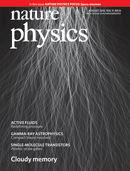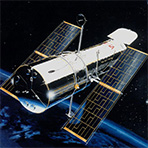|
|
 |
TABLE OF CONTENTS
|
August 2015 Volume 11, Issue 8 |
 |  |  |
 |  Focus Focus
 Editorial Editorial
 Commentaries Commentaries
 Thesis Thesis
 Research Highlights Research Highlights
 News and Views News and Views
 Progress Article Progress Article
 Letters Letters
 Articles Articles
 Futures Futures | |
 |
|
 |
 |
| Advertisement |
 |
Open for Submissions
A new open access, online-only, multidisciplinary research journal dedicated to publishing the most important scientific advances in the life sciences, physical sciences, and engineering fields that are facilitated by spaceflight and analogue platforms.
Explore the benefits of submitting your next research article. |  | | |
 |
| |
Focus |  Top Top |
 |
 |
| Focus on Space missions |  | | This Focus celebrates an exciting year in space science, marking the twenty-fifth anniversary of the launch of the Hubble Space Telescope. In addition, four new space missions are exploring the Earth's magnetosphere, the dwarf planets Ceres and Pluto and testing equipment for measuring gravitational waves. And we are now looking at quantum technologies for future space missions.
Image: http://www.spacetelescope.org/images/hubble002/
Focus Space missions |
|
 |
Editorial |  Top Top |
 |
 |
 |
Focus on Space missions
More space p605
doi:10.1038/nphys3443
As we celebrate the twenty-fifth anniversary of the Hubble Space Telescope, there is plenty to look back on and even more to look forward to. |
 |
Commentaries |  Top Top |
 |
 |
 |
Focus on Space missions
Hubble's biggest fan pp607 - 608
Luis C. Ho
doi:10.1038/nphys3409
What is it about the Hubble Space Telescope that so captivates its users and the public at large? I offer my personal views on this iconic telescope. |
 |
 |
 |
Focus on Space missions
Exploring the dwarf planets pp608 - 611
William B. McKinnon
doi:10.1038/nphys3394
This year, NASA's Dawn and New Horizons rendezvoused with Ceres and Pluto, respectively. These worlds, despite their modest sizes, have much to teach us about the accretion of the Solar System and its dynamical evolution. |
 |
 |
 |
Focus on Space missions
Magnetic reconnection pp611 - 613
Thomas Earle Moore, James L. Burch and Roy B. Torbert
doi:10.1038/nphys3393
A new NASA mission will reveal the electron-scale physics of magnetic reconnection, a process that connects our planet to the rest of the Universe. |
 |
 |
 |
Focus on Space missions
LISA and its pathfinder pp613 - 615
Karsten Danzmann for the LISA Pathfinder Team & the eLISA Consortium
doi:10.1038/nphys3420
On astronomical scales, gravity is the engine of the Universe. The launch of LISA Pathfinder this year to prepare the technology to detect gravitational waves will help us 'listen' to the whole Universe. |
 |
 |
 |
Focus on Space missions
Ψ in the sky pp615 - 617
Kai Bongs, Michael Holynski and Yeshpal Singh
doi:10.1038/nphys3427
Quantum technologies, including quantum sensors, quantum communication and quantum metrology, represent a growing industry. Out in space, such technologies can revolutionize the way we communicate and observe our planet. |
 |
Thesis |  Top Top |
 |
 |
 |
Almost action at a distance p619
Mark Buchanan
doi:10.1038/nphys3429 |
 |
Research Highlights |  Top Top |
 |
 |
 |
Complex networks: Bring the noise | Dwarf galaxies: Plane speaking | Spectrometry: Connect the dots | Valleytronics: Jump across | Random walks: Competitive advantage |
News and Views |  Top Top |
 |
 |
 |
|
 |
Progress Article |  Top Top |
 |
 |
 |
Structured quantum waves pp629 - 634
Jérémie Harris, Vincenzo Grillo, Erfan Mafakheri, Gian Carlo Gazzadi, Stefano Frabboni et al.
doi:10.1038/nphys3404
Similar to orbital angular momentum-carrying optical beams, it is now possible to engineer structured electron beams that could find applications in imaging, nanofabrication and the study of fundamental phenomena. |
 |
Letters |  Top Top |
 |
 |
 |
Resolving the vacuum fluctuations of an optomechanical system using an artificial atom pp635 - 639
F. Lecocq, J. D. Teufel, J. Aumentado and R. W. Simmonds
doi:10.1038/nphys3365
Vacuum fluctuations in a ground-state mechanical oscillator are hard to distinguish from noise, but by using the coupling with a superconducting qubit in a microwave cavity one can amplify and convert them to directly measurable real photons. |
 |
 |
 |
Gating a single-molecule transistor with individual atoms pp640 - 644
Jesús Martínez-Blanco, Christophe Nacci, Steven C. Erwin, Kiyoshi Kanisawa, Elina Locane et al.
doi:10.1038/nphys3385
Transistors rely on electrical gates to control conductance but this is challenging on the atomic-scale. It is now shown that individual charged atoms can be used to electrostatically gate a single-molecule transistor with sub-ångström precision. |
 |
 |
 |
Extremely large magnetoresistance and ultrahigh mobility in the topological Weyl semimetal candidate NbP pp645 - 649
Chandra Shekhar, Ajaya K. Nayak, Yan Sun, Marcus Schmidt, Michael Nicklas et al.
doi:10.1038/nphys3372
Weyl semimetals are predicted to exhibit a host of unusual transport properties. NbP, a system predicted to share characteristics of both normal and Weyl semimetals, is now shown to have a very large, non-saturating magnetoresistance. |
 |
 |
 |
Linear magnetoresistance in mosaic-like bilayer graphene pp650 - 653
Ferdinand Kisslinger, Christian Ott, Christian Heide, Erik Kampert, Benjamin Butz et al.
doi:10.1038/nphys3368
Contrary to common belief, bilayer graphene is not defect-free: the abundance of partial dislocations leads to a mosaic-like network structure. As a result, as now shown, the magnetoresistance of bilayer graphene depends linearly, rather than quadratically, on the external magnetic field. |
 |
 |
 |
Probing molecular chirality on a sub-femtosecond timescale pp654 - 658
R. Cireasa, A. E. Boguslavskiy, B. Pons, M. C. H. Wong, D. Descamps et al.
doi:10.1038/nphys3369
Molecules that are mirror images of each other usually behave identically, unless they are interacting with other chiral objects. High-harmonic generation can provide access to the dynamics of chiral interactions on ultrafast timescales.
See also: News and Views by Cho |
 |
 |
 |
Adaptation to sensory input tunes visual cortex to criticality pp659 - 663
Woodrow L. Shew, Wesley P. Clawson, Jeff Pobst, Yahya Karimipanah, Nathaniel C. Wright et al.
doi:10.1038/nphys3370
Sensory nervous systems adapt to their environment—a mechanism thought to ensure network dynamics remain critical. Visual cortex experiments show that adaptation maintains criticality even as sensory input drives the system away from this regime. |
 |
 |
 |
Central engine of a gamma-ray blazar resolved through the magnifying glass of gravitational microlensing pp664 - 667
Andrii Neronov, Ievgen Vovk and Denys Malyshev
doi:10.1038/nphys3376
A foreground galaxy cluster is magnifying a more distant blazar by gravitationally bending the emitted radiation. Using such a lens, it is possible to resolve a jet close to the central supermassive black hole as being the source of the gamma rays. |
 |
Articles |  Top Top |
 |
 |
 |
Universal decoherence due to gravitational time dilation pp668 - 672
Igor Pikovski, Magdalena Zych, Fabio Costa and Časlav Brukner
doi:10.1038/nphys3366
Gravity and quantum mechanics are expected to meet at extreme energy scales, but time dilation could induce decoherence even at low energies affecting microscopic objects—a prospect that could be tested in future matter-wave experiments.
See also: News and Views by Bassi |
 |
 |
 |
Pressure is not a state function for generic active fluids pp673 - 678
A. P. Solon, Y. Fily, A. Baskaran, M. E. Cates, Y. Kafri et al.
doi:10.1038/nphys3377
The pressure that a fluid of self-propelled particles exerts on its container is shown to depend on microscopic interactions between fluid and container, suggesting that there is no equation of state for mechanical pressure in generic active systems. |
 |
 |
 |
Spin-disordered quantum phases in a quasi-one-dimensional triangular lattice pp679 - 683
Yukihiro Yoshida, Hiroshi Ito, Mitsuhiko Maesato, Yasuhiro Shimizu, Hiromi Hayama et al.
doi:10.1038/nphys3359
Materials expected to support a quantum-spin-liquid phase are typically characterized by geometrical frustration. A new candidate has a distorted lattice that compensates for diminished frustration with reduced dimensionality. |
 |
 |
 |
Translation correlations in anisotropically scattering media pp684 - 689
Benjamin Judkewitz, Roarke Horstmeyer, Ivo M. Vellekoop, Ioannis N. Papadopoulos and Changhuei Yang
doi:10.1038/nphys3373
Light propagating through a scattering medium exhibits correlations in the transmission matrix. A theoretical and experimental study uncovers intensity correlations that survive multiple scattering, which could be exploited for imaging.
See also: News and Views by Bertolotti |
 |
 |
 |
Secondary reconnection sites in reconnection-generated flux ropes and reconnection fronts pp690 - 695
Giovanni Lapenta, Stefano Markidis, Martin V. Goldman and David L. Newman
doi:10.1038/nphys3406
New three-dimensional simulations of magnetic reconnection suggest the existence of secondary reconnection sites that could be observed by the new NASA Magnetospheric MultiScale Mission. |
 |
Futures |  Top Top |
 |
 |
 |
Overseer p696
Aldous Mercer
doi:10.1038/nphys3444
Two's company. |
 |
 Top Top |
 |
 |
 |
| |
 |  |  |  |  |  | Natureevents is a fully searchable, multi-disciplinary database designed to maximise exposure for events organisers. The contents of the Natureevents Directory are now live. The digital version is available here.
Find the latest scientific conferences, courses, meetings and symposia on natureevents.com. For event advertising opportunities across the Nature Publishing Group portfolio please contact natureevents@nature.com |  |  |  |  |  |
|
 |


No comments:
Post a Comment